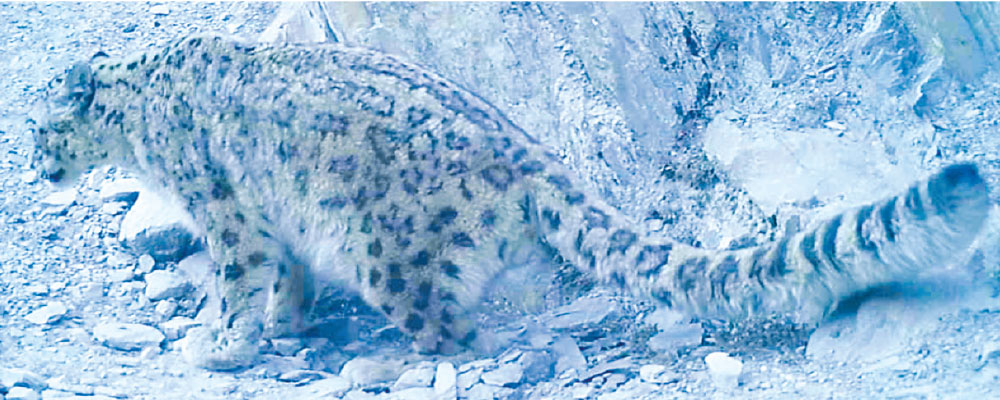
Kathmandu, May 8: A scientific study conducted in the Manaslu Conservation Area in Gorkha district to ascertain the population of snow leopards found a total of 13 adult animals, excluding two cubs.
At least 60 remote camera traps were placed, covering around 300 square kilometers at each site. So, in total, 120 camera traps were installed, covering around 600 square kilometers in both valleys, said Dr. Bikram Shrestha, a researcher at the Global Change Research Institute, Czech Academy of Sciences (GCRI), Czech Republic.
Dr. Shrestha claimed that this is the first scientific study of its kind of scientific and proper study in the Manaslu area to ascertain the number of snow leopards. “Cameras were placed at altitudes ranging from 2,500 meters to 5,000 meters. We identified individual snow leopards by their distinct pelage patterns,” he informed.
According to Dr. Shrestha, other analyses are ongoing, including density analysis using appropriate models, assessment of climate change impact, evaluation of predator habitat, analysis of activity patterns, and examination of interactions with prey species and other co-occurring predators such as the Himalayan wolf, common leopard, and golden jackal. The research was led by Dr. Bikram Shrestha along with his Master’s degree student. The study areas included the Western site of the Manaslu Conservation Area, spanning from Bhi to Samdo in Nubri Valley, surveyed from November 2020 to January 2021. Similarly, the Eastern side at Chum Valley, covering from Chumling to MuGomba-Kalung, was surveyed from December 2021 to February 2022.
Senior conservationist Karan Shah said that the Manaslu Conservation Area is renowned as a prime habitat for the snow leopard, with historical incidents of conflict between snow leopards and leopards occurring in the region.
Similarly, the World Wildlife Conservation also conducted a study by a systematic camera trap survey to establish the snow leopard population in eastern Dolpa in areas outside of Shey Phoksundo National Park (SPNP).
The survey, which covered Chharka Tangsong, Kaike, and Dolpo Buddha Rural Municipalities, has indicated a population of 30 snow leopards in the area. The camera traps were deployed in altogether 66 locations by 33 citizen scientists, 7 DFO staff, and three students for 60 days, covering nearly 2000 km2 in the trans-Himalayan alpine belt. The population density was estimated at 1.5 snow leopards per 100 km2. This differs slightly from an earlier survey within SPNP that estimated a density of 2.2 per 100 km2 with an abundance of 90 snow leopards.
“This survey has for the first time provided robust evidence of good density of Snow Leopards outside PAs. The survey will contribute to understanding Nepal’s snow leopard population and has further established the need for strong conservation efforts out of PAs. We congratulate DFO Dolpa on this accomplishment and are proud to have contributed alongside the researchers, citizen scientists, indigenous local communities, and WWF Nepal,” said Shiva Kumar Wagle, Director-General of DoFSC.
Around 42 per cent of the 30,000 km2 of Snow Leopard habitat in Nepal falls outside of Protected Areas. These areas are crucial both as habitats and as corridors. The critical habitat of eastern Dolpa connects snow leopard populations of three protected areas of Nepal (SPNP, Dhorpatan Hunting Reserve, and Annapurna Conservation Area) and two snow leopard conservation landscapes (western and central).
“Globally, Snow Leopards are one of the most understudied species among the big cats due to their large and remote geographical range. The Nepal government has given high priority to the study of this elusive species and continues to contribute to their understanding and conservation on a global scale. WWF Nepal is proud to support the government and partner with local communities in this endeavour for the long-term survival of snow leopards,” said Dr. Ghana Shyam Gurung, Country Representative of WWF Nepal. “WWF Nepal will continue our community-based conservation efforts to ensure that Snow Leopards and local communities thrive together,” he added.












